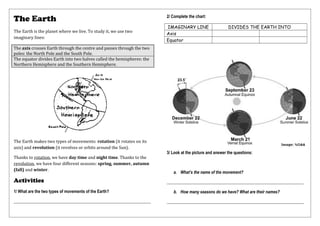The Earth: Rotation, Revolution, Axis, Equator
•Download as DOC, PDF•
4 likes•8,190 views
Report
Share
Report
Share

Recommended
More Related Content
What's hot
What's hot (20)
Class 7 chapter 6 , natural vegetation and wild life 

Class 7 chapter 6 , natural vegetation and wild life
Understanding quadrilaterals chapter3 grade 8 cbse

Understanding quadrilaterals chapter3 grade 8 cbse
Similar to The Earth: Rotation, Revolution, Axis, Equator
Similar to The Earth: Rotation, Revolution, Axis, Equator (20)
More from Jose Martínez Alcolea
More from Jose Martínez Alcolea (20)
The Earth: Rotation, Revolution, Axis, Equator
- 1. The Earth The Earth is the planet where we live. To study it, we use two imaginary lines: The axis crosses Earth through the centre and passes through the two poles: the North Pole and the South Pole. The equator divides Earth into two halves called the hemispheres: the Northern Hemisphere and the Southern Hemisphere. The Earth makes two types of movements: rotation (it rotates on its axis) and revolution (it revolves or orbits around the Sun). Thanks to rotation, we have day time and night time. Thanks to the revolution, we have four different seasons: spring, summer, autumn (fall) and winter. Activities 1/ What are the two types of movements of the Earth? __________________________________________________________________ 2/ Complete the chart: IMAGINARY LINE DIVIDES THE EARTH INTO Axis Equator 3/ Look at the picture and answer the questions: a. What’s the name of the movement? __________________________________________________________________ b. How many seasons do we have? What are their names? __________________________________________________________________
